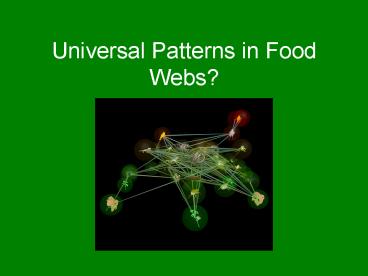Universal Patterns in Food Webs? PowerPoint PPT Presentation
Title: Universal Patterns in Food Webs?
1
Universal Patterns in Food Webs?
- Benjamin Good
2
What is the evidence?
- Paper by Camacho et al. claims to demonstrate
some traits common to all food web networks - Uses the niche model to make theoretical
predictions and then compares predictions to data
from 7 different food webs
3
The Model
- Niche Parameter chosen bynirandom(0,1),
i1,,S - Species eat prey in a range given byrixni
wherep(x) b(1-x)(b-1) , 0 lt x lt 1,
andb(S2/2L 1) - This range centered on cirandom(ri/2, ni)
- Hence, a list of prey or a list of predators can
be calculated for each species
Sample Web
4
The Predictions
- In another paper, they used this model to derive
expressions for Pprey(k) and Ppred(k) - Pprey(k) is the probabilitythat a given species
hask or more prey, Ppred(k) isthe probability
that aspecies has k or more predators.
5
Initial Results
- Using data from the St. Martin Island web, with
an empirically measured value for z, the data fit
the model quite well. - No fitting parameters at all!
6
Taking the idea further
- Instead of the distribution of number of prey,
they use the scaled number of prey k/2z and the
scaled number of predators m/2z and
obtain - Now the same function works for all 7 food webs
and still without any fitting parameters!
7
and further
- By pooling the data from all 7 webs, they
construct a master plot again with no
fit parameters
8
Havent seen a fit this good since
especially when compared to the modelswe have
been dealing with so far.
9
Other predictions
- Amazingly, the same model predictsseveral
other network characteristicsquite well number
of links per species, raverage distance,
dclustering coefficient, C
10
Compared to older studies
- Rejects the scale-free hypothesis that had been
established earlier - Also rejects the small world hypothesis for food
webs - Hypothesizes a single functional form for various
food web properties
11
Response to this article
- A later study by Dunne, Williams, and Martinez
extended the data to include 16 data sets in
total.
12
Results from Dunne, et al
Three differentfunctional forms(instead of 1)
13
Yet some similarities remain
- Confirmed the earlierresults for a certain
levelof connectedness - Also rejected bothscale-free and
small-worldhypotheses - Some of the differencesin functional form
attributedto poor data collectionor extremely
specializedwebs
14
The End

